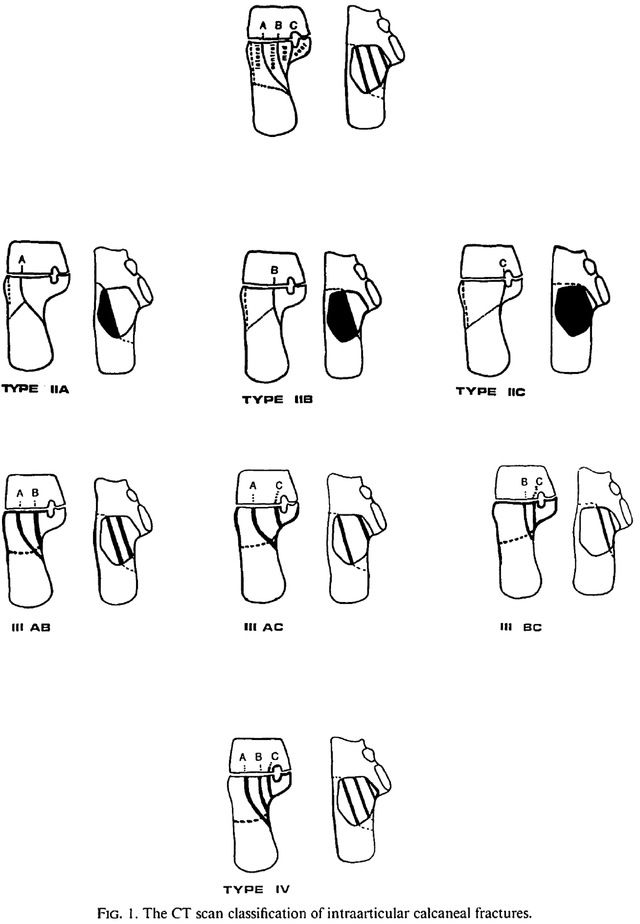د دې پوښتنې ځواب دا دی چې د داخلي فکس کولو په وخت کې د پښې د ماتیدو لپاره د هډوکي پیوند کولو ته اړتیا نشته.
سینډرز وویل
په ۱۹۹۳ کال کې، سانډرز او نورو [۱] په CORR کې د هډوکو د هډوکو د هډوکو د هډوکو د جراحي درملنې په تاریخ کې د CT پر بنسټ د هډوکو
د پښې د ماتیدو CT ټایپ کول چې د سانډرز او نورو لخوا په 1993 کې په CORR کې خپور شو.
د هډوکو پیوند کول دوه اصلي موخې لري: د میخانیکي ملاتړ لپاره ساختماني پیوند کول، لکه په فیبولا کې، او د هډوکو د ډکولو او هڅولو لپاره دانه پیوند کول.
سانډرز یادونه وکړه چې د پښې هډوکي د لوی کورټیکل شیل څخه جوړ دی چې د کینسلس هډوکي پوښل شوی، او دا چې د کینسلس هډوکي بې ځایه شوي داخلي آرټیکولر فریکچرونه په چټکۍ سره د کینسلس هډوکي لخوا د ټریبیکولر جوړښت سره بیا رغول کیدی شي که چیرې د کورټیکل شیل نسبتا بیا تنظیم شي. پامر او نور [3] لومړی کس وو چې په 1948 کې د هډوکي ګرافټینګ په اړه راپور ورکړ ځکه چې په هغه وخت کې د آرټیکولر سطحې فریکچر ساتلو لپاره د مناسب داخلي فکسیشن وسیلو نشتوالی و. د داخلي فکسیشن وسیلو لکه پوسټرو لیټرل پلیټونو او پیچونو دوامداره پراختیا سره، د هډوکي ګرافټ له لارې د کمولو ملاتړ ساتنه غیر ضروري شوه. د دې اوږدمهاله کلینیکي مطالعاتو دا نظر تایید کړی.
کلینیکي کنټرول شوې مطالعې پایله کړې چې د هډوکو پیوند کول غیر ضروري دي
لونګینو او نورو [4] او نورو د لږترلږه 2 کلونو تعقیب سره د پښې د 40 بې ځایه شوي داخلي-آرټیکولر فریکچرونو احتمالي کنټرول شوی مطالعه ترسره کړه او د عکس اخیستنې یا فعال پایلو له مخې د هډوکي پیوند کولو او د هډوکي پیوند کولو ترمنځ هیڅ مهم توپیر ونه موند. ګوسیک او نورو [5] د ورته پایلو سره د پښې د 143 بې ځایه شوي داخلي-آرټیکولر فریکچرونو کنټرول شوی مطالعه ترسره کړه.
د مایو کلینیک څخه سینګ او نور [6] د 202 ناروغانو یوه شاته مطالعه ترسره کړه او که څه هم د هډوکو پیوند کول د بوهلر زاویه او وخت له مخې د بشپړ وزن برداشت کولو څخه غوره وو، په فعال پایلو او پیچلتیاو کې د پام وړ توپیر نه و.
د هډوکو پیوند کول د صدماتو د اختلاطاتو لپاره د خطر فکتور په توګه
پروفیسور پان ژیجون او د هغه ټیم په ژیجیانګ طبي دوهم روغتون کې په ۲۰۱۵ کال کې یو منظم ارزونه او میټا تحلیل ترسره کړ [7]، چې ټول هغه ادبیات پکې شامل وو چې د ۲۰۱۴ کال پورې د بریښنایی ډیټابیسونو څخه ترلاسه کیدی شي، په شمول د ۱۵۵۹ ناروغانو کې ۱۶۵۱ مات شوي هډوکي، او دې پایلې ته ورسیدل چې د هډوکي پیوند کول، د شکر ناروغۍ میلیتس، د اوبو ایستلو ځای نه ایښودل، او شدید مات شوي هډوکي د عملیاتو وروسته د صدماتو پیچلتیاو خطر د پام وړ زیاتوي.
په پایله کې، د پښې د ماتیدو د داخلي فکس کولو په وخت کې د هډوکي پیوند کول اړین ندي او په فعالیت یا وروستۍ پایلې کې مرسته نه کوي، بلکه د صدماتو پیچلتیاو خطر زیاتوي.
۱. سانډرز آر، فورټین پي، ډی پاسکویل ټي، او نور. د ۱۲۰ بې ځایه شویو انټرا آرټیکولر کیلکینیال فریکچرونو کې عملیاتي درملنه. د پروګنوسټیک کمپیوټري ټوموګرافي سکین طبقه بندي په کارولو سره پایلې. د کلینیک اورتوپ ریلیټ ریس. ۱۹۹۳;(۲۹۰):۸۷-۹۵.
۲. سانډرز آر، واوپل زیډ ایم، اردګان ایم، او نور. د بې ځایه شوي انټرا آرټیکولر کیلکینیال فریکچرونو عملیاتي درملنه: اوږدمهاله (۱۰-۲۰ کاله) د پروګنوسټیک CT طبقه بندي په کارولو سره د ۱۰۸ فریکچرونو پایله لري. جي اورتوپ ټروما. ۲۰۱۴;۲۸(۱۰):۵۵۱-۶۳.
۳. پامر I. د کلسینیوس د ماتیدو میکانیزم او درملنه. د J هډوکي ګډ جراحي ام. ۱۹۴۸; ۳۰ الف: ۲-۸.
۴. لونګینو ډي، بکلي آر ای. د هډوکو ګرافټ د بې ځایه شوي انټرا آرټیکولر کیلکانیال فریکچرونو عملیاتي درملنه کې: ایا دا ګټور دی؟ جي آرتپ ټروما. ۲۰۰۱;۱۵(۴):۲۸۰-۶.
۵. ګوسیک این، فیډل آی، ډارابوس این، او نور. د انټرا آرټیکولر کیلکینیال فریکچر عملیاتي درملنه: د دریو مختلفو عملیاتي تخنیکونو اناتومي او فعاله پایله. ټپ. ۲۰۱۵؛ ۴۶ ضمیمه ۶: S130-3.
۶. سنګ اې کې، وینای کې. د هډوکو
۷. ژانګ ډبلیو، چن ای، ژو ډي، او نور. د جراحي وروسته د تړل شوي کیلکانیل فریکچرونو د زخم پیچلتیاو لپاره د خطر عوامل: یو سیستماتیک بیاکتنه او میټا تحلیل. سکینډ جي ټراما ریسسک ایمرج میډ. ۲۰۱۵؛ ۲۳:۱۸.
د پوسټ وخت: دسمبر-۰۷-۲۰۲۳











